The Intel Broadwell Review Part 2: Overclocking, IPC and Generational Analysis
by Ian Cutress on August 3, 2015 8:00 AM ESTGaming Benchmarks: High End
At the top of the line we take the best GPUs on the market from May 2015 - an AMD R9 290X and an NVIDIA GTX 980.
Alien: Isolation
If first person survival mixed with horror is your sort of thing, then Alien: Isolation, based off of the Alien franchise, should be an interesting title. Developed by The Creative Assembly and released in October 2014, Alien: Isolation has won numerous awards from Game Of The Year to several top 10s/25s and Best Horror titles, ratcheting up over a million sales by February 2015. Alien: Isolation uses a custom built engine which includes dynamic sound effects and should be fully multi-core enabled.
For low end graphics, we test at 720p with Ultra settings, whereas for mid and high range graphics we bump this up to 1080p, taking the average frame rate as our marker with a scripted version of the built-in benchmark.
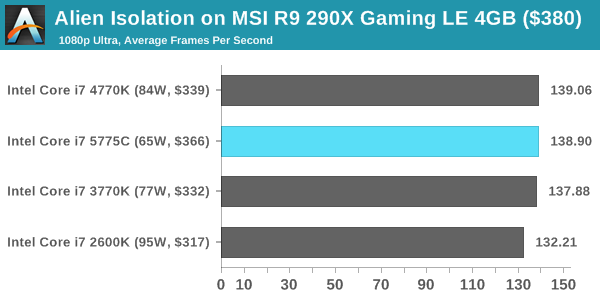
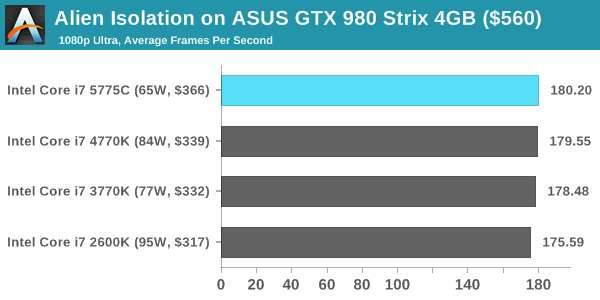
Total War: Attila
The Total War franchise moves on to Attila, another The Creative Assembly development, and is a stand-alone strategy title set in 395AD where the main story line lets the gamer take control of the leader of the Huns in order to conquer parts of the world. Graphically the game can render hundreds/thousands of units on screen at once, all with their individual actions and can put some of the big cards to task.
For low end graphics, we test at 720p with performance settings, recording the average frame rate. With mid and high range graphics, we test at 1080p with the quality setting. In both circumstances, unlimited video memory is enabled and the in-game scripted benchmark is used.
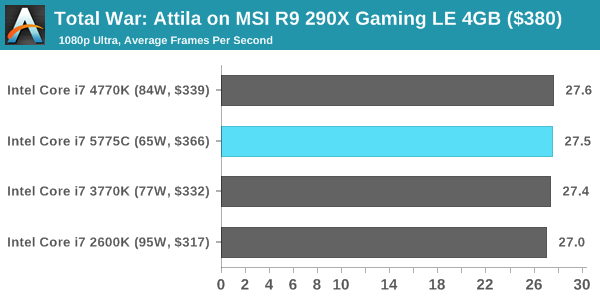

Grand Theft Auto V
The highly anticipated iteration of the Grand Theft Auto franchise finally hit the shelves on April 14th 2015, with both AMD and NVIDIA in tow to help optimize the title. GTA doesn’t provide graphical presets, but opens up the options to users and extends the boundaries by pushing even the hardest systems to the limit using Rockstar’s Advanced Game Engine. Whether the user is flying high in the mountains with long draw distances or dealing with assorted trash in the city, when cranked up to maximum it creates stunning visuals but hard work for both the CPU and the GPU.
For our test we have scripted a version of the in-game benchmark, relying only on the final part which combines a flight scene along with an in-city drive-by followed by a tanker explosion. For low end systems we test at 720p on the lowest settings, whereas mid and high end graphics play at 1080p with very high settings across the board. We record both the average frame rate and the percentage of frames under 60 FPS (16.6ms).
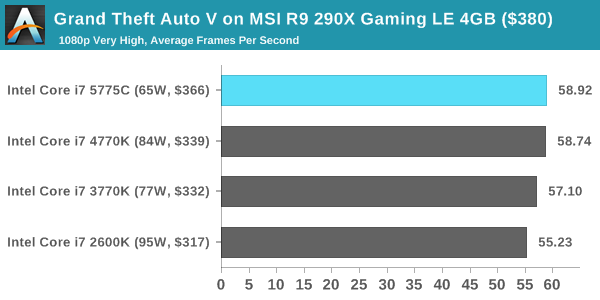
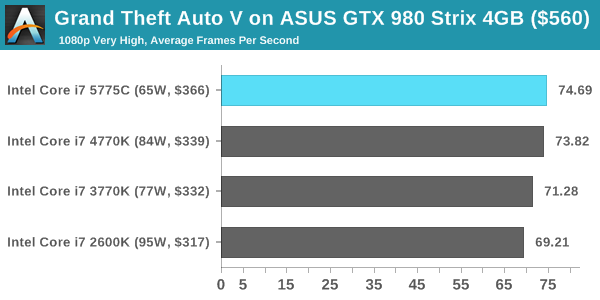
GRID: Autosport
No graphics tests are complete without some input from Codemasters and the EGO engine, which means for this round of testing we point towards GRID: Autosport, the next iteration in the GRID and racing genre. As with our previous racing testing, each update to the engine aims to add in effects, reflections, detail and realism, with Codemasters making ‘authenticity’ a main focal point for this version.
GRID’s benchmark mode is very flexible, and as a result we created a test race using a shortened version of the Red Bull Ring with twelve cars doing two laps. The car is focus starts last and is quite fast, but usually finishes second or third. For low end graphics we test at 1080p medium settings, whereas mid and high end graphics get the full 1080p maximum. Both the average and minimum frame rates are recorded.
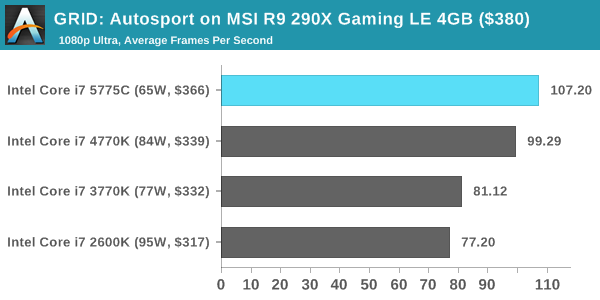
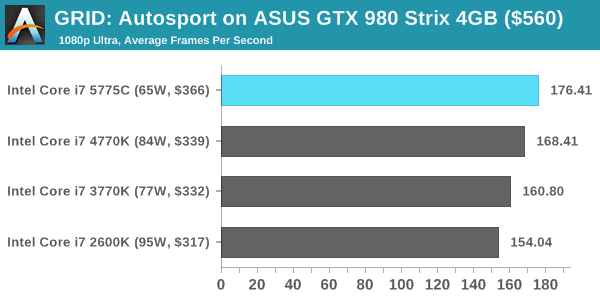
Middle-Earth: Shadows of Mordor
The final title in our testing is another battle of system performance with the open world action-adventure title, Shadows of Mordor. Produced by Monolith using the LithTech Jupiter EX engine and numerous detail add-ons, SoM goes for detail and complexity to a large extent, despite having to be cut down from the original plans. The main story itself was written by the same writer as Red Dead Redemption, and it received Zero Punctuation’s Game of The Year in 2014.
For testing purposes, SoM gives a dynamic screen resolution setting, allowing us to render at high resolutions that are then scaled down to the monitor. As a result, we get several tests using the in-game benchmark. For low end graphics we examine at 720p with low settings, whereas mid and high end graphics get 1080p Ultra. The top graphics test is also redone at 3840x2160, also with Ultra settings, and we also test two cards at 4K where possible.
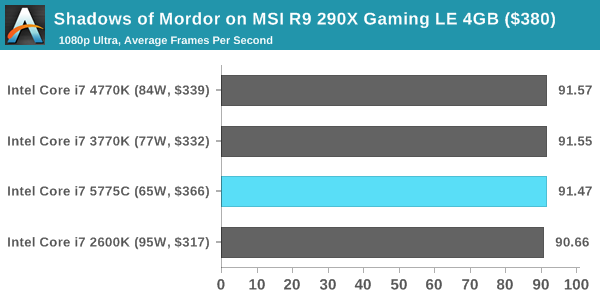
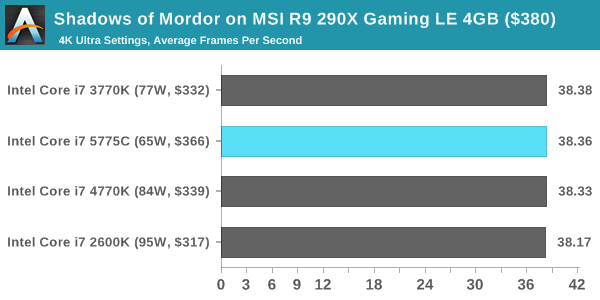
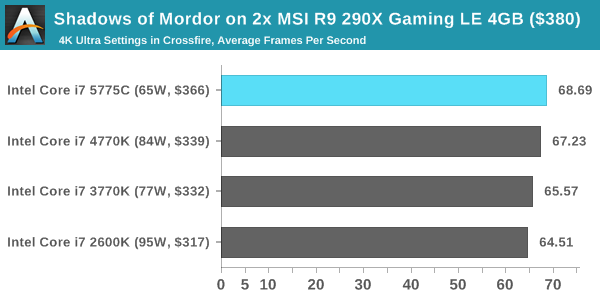
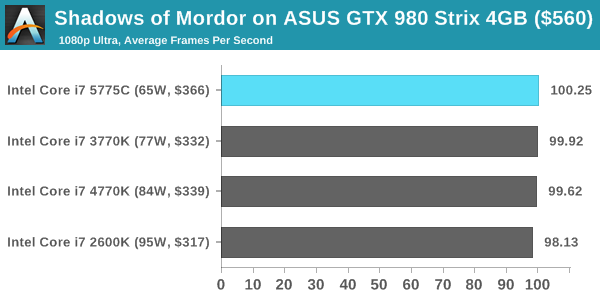
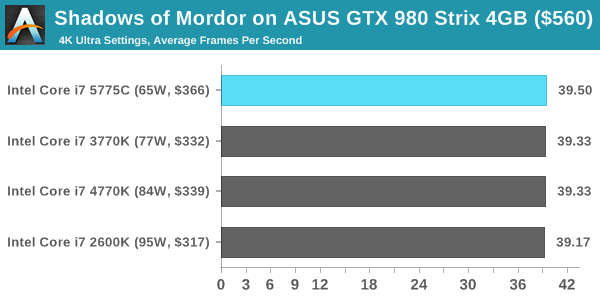
















121 Comments
View All Comments
doggface - Tuesday, August 4, 2015 - link
Can intel please bring out a processor that destroys Sandy Bridge so that I don't have to hear all the smug comments every time they release a processor. I am so bored by them. Cant we talk about something interesting, like why is crystal well such a big focus for them when apparently all anyone wants in the enthusiast bracket is raw power?jrs77 - Tuesday, August 4, 2015 - link
And now look at all the PC-users who don't play games, but use their PCs for doing actual work.No tests of professional graphics software like Photoshop, Premiere, etc. No tests of professional audio-software like Reason, CuBase, etc. No tests of professional 3d-software that actually would benefit from the IrisPro and it's GPGPU-capabilities - and no, Cinebench is only for CPU-based rendering, so it doesn't count that much for stuff like flowsimulations done in Solidworks etc.
The i7-5775C is currently the best CPU outthere for small workstations, due to the very powerful IrisPro and the low TDP. You can build a very powerful rig in a box as small as the MacMini while still keeping the advantage of the 4C/8T CPU and an iGPU as powerful as a R7-250/GT740.
And this rig would only draw some 150W under full load, which is totally doable with a picoPSU.
I'm getting my i7-5775C finally delivered sometime next week, after waiting for 2 month, and I can finally build the rig I've allways wanted to combined with the following: Antec ISK110, picoPSU 160XT, Noctua NH-L9i, 2x SSD (256/512 GB) and 16GB DDR3.
Strapped to the back of my screen, allmost inaudible and very low power-draw.
This CPU is ment for SFF-workstations, but for this niche it's the best there is.
MrSpadge - Tuesday, August 4, 2015 - link
Thanks for the detailed review, Ian! As far as I know it's the most detailed out yet. And probably the last one, with Skylake hopefully just around the corner.Anyway, I would really like to see how low the power consumption of this chip can go. It's obviously optimized for mobile and low clocks, so pushing it to high clocks and high voltages (even the stock voltage is a lot for 14 nm!) is not showing it in its best light. When you tested the voltage scaling I would really like to see the minimum voltage needed to get to the lower speeds (you just left it at stock). How low can the power consumption of this chip become at ~1.0 V? Which clock speed hit does it take to get there? (btw: I run my 3770K at 4.0 GHz and a bit over 1.0 V, which is great for 24/7 load)
zlandar - Tuesday, August 4, 2015 - link
No reason to replace my 4 year-old i7-2600k for gaming. Kinda nutty since I just installed my 3rd video card on the same system.joanwa - Tuesday, August 4, 2015 - link
Concerning the Linux Performance, could one kindly ask for another software to be benchmarked? NAMD is nice, but the to my knowledge the bigger share of the scientific community in molecular dynamics uses Gromacs (www.gromacs.org), which is also much faster and better optimized for current Hardware (AVX2 support for instance, multiple GPU support) and has a bigger community around it.Morg72 - Tuesday, August 4, 2015 - link
I'm still rockin' an i7-950, ASUS P6X58D-E, 12gb DDR3 1600 and 2x 6870's in Crossfire. The only part showing me its age is the 6870's (probably going to upgrade next GPU gen). The rest runs everything I throw at it perfectly and that's at stock speed. I can always get a better CPU cooler and OC it for more longevity. Intel really needs to get things together. Hope Zen gives them a push.nagi603 - Wednesday, August 5, 2015 - link
4770k owner here... If this is how Intel upgrades, I won't be changing this baby out for a decade.Lazn_W - Wednesday, August 5, 2015 - link
My question is: Does the L4 cache help with multi threaded use? Say a home Hyper-V server lab environment? It might make the 5775C a better buy than one of the hex core 2111 socket CPUs..Jetpil0t - Thursday, August 6, 2015 - link
They should put out a multi-threaded K series 4 core with no IGP at a basement price for the more value minded people, gamers specifically, especially considering the main purpose of upgrading are the tertiary features on the motherboard. I doubt anyone with a Sandy is looking at this with any interest. Especially considering my Sandy board has PCIe3.0 and Sata 6Gbps and rocks 4-4.5 Ghz easily.SanX - Friday, August 7, 2015 - link
Big fart of Intel.Remember AMD Bulldozer?
Heads will be rolling.